 Germany (1911) Magdeburg, Breslau, Strassburg, Stralsund
Germany (1911) Magdeburg, Breslau, Strassburg, StralsundWW1 German Cruisers
Irene class | SMS Gefion | SMS Hela | SMS Kaiserin Augusta | Victoria Louise class | Prinz Adalbert class | SMS Prinz Heinrich | SMS Fürst Bismarck | Roon class | Scharnhorst class | SMS BlücherBussard class | Gazelle class | Bremen class | Kolberg class | Königsberg class | Nautilus class | Magdeburg class | Dresden class | Graudenz class | Karlsruhe class | Pillau class | Wiesbaden class | Karlsruhe class | Brummer class | Königsberg ii class | Cöln class
A brand new league in German cruiser design: The Magdeburg class marked a new milestone in the design of German cruisers. Significantly larger than the Kolberg (5600 tons against 4900 fully loaded), they focused also on a range of significant improvements. These four ships (Magdeburg, Breslau, Strassburg, Stralsund) were completed in August-December 1912 and had a quite significant and active carrer.
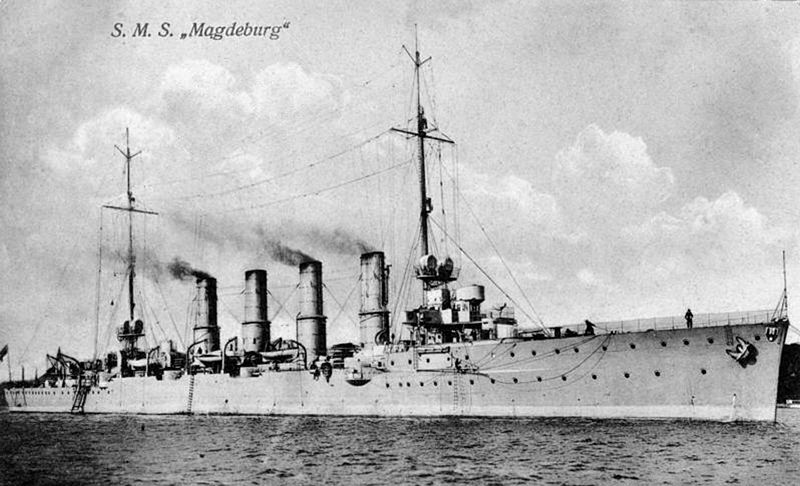
SMS Magdeburg
Design
Innovative features:
They were the first cruisers fitted with a steel belt reinforced by nickel running on 80% of the waterline, and welded to the hull itself, as part of its structure. The hull itself used a technique of longitudinal frames. Also numerous tests were made with models in basin and hydrodynamic features has been reworked extensively, as evidenced externally by the clipper bow.
An old feature also disappeared: The quarterdeck’s removal was a necessity to give these ships minelaying capability.
Protection
As said, the Magdeburg class cruisers were protected by a waterline armored belt, 60 mm (2.4 in) in thickness. It was reduced down to 18 mm (0.71 in) on the bow while the stern section was unarmored. The armoured deck was covered by a 60 mm thick plate forward, down to 40 mm (1.6 in) amidships, and reduced to 20 mm (0.79 in) aft. The slopes connecting it to the belt was 40 mm thick. There is no information about bulkheads. The conning tower however had 100 mm (3.9 in) thick walls, while the roof was protected by 20 mm or armor. The rangefinder was protected by 30 mm steel plating and the gun shields for the main 6-in guns were covered by 50 mm (2.0 in) armor. A good abalance overall which made them almost immune against destroyer fire. However there was no specific ASW protection outside internam compartimentation.
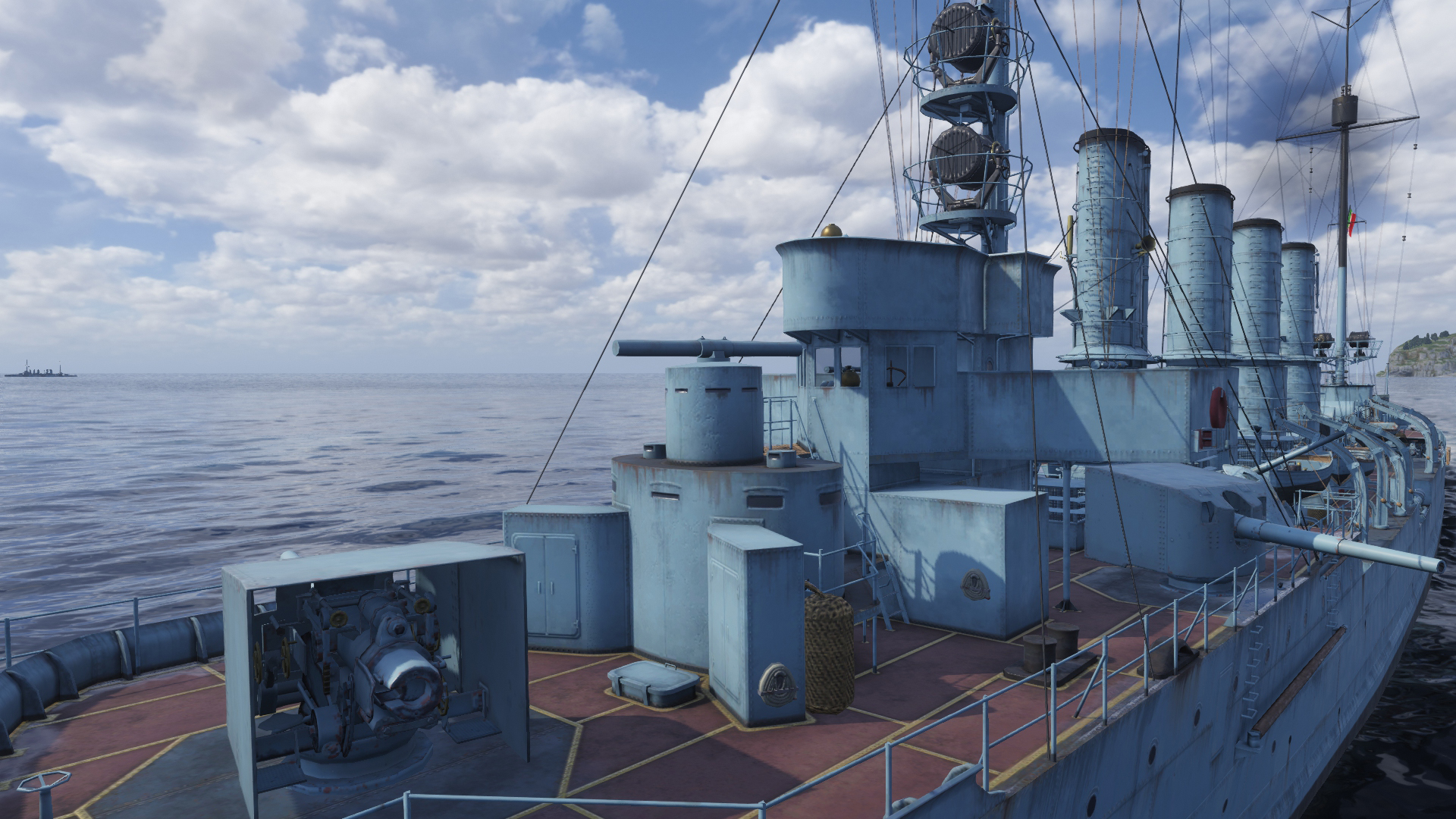
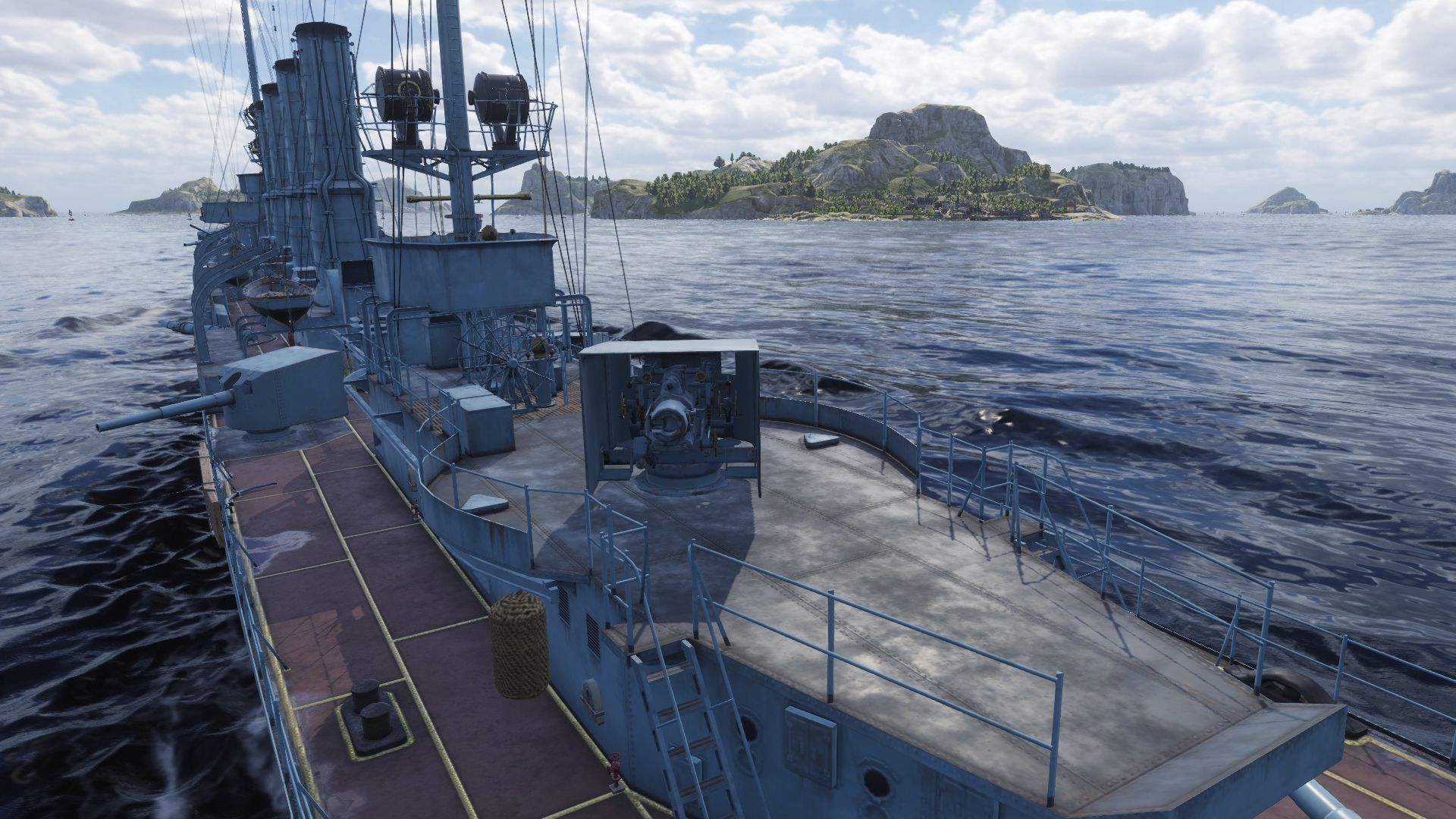
Wow’s rendition of the Magdeburg class, aft and fore view details – Italian Taranto.
Propulsion
These ships had different turbines, and admitted speeds between 27.5 and 28.2 knots. Indeed, these steam turbines varied among different manufacturers. This was on purpose, in order to evaluate the best configuration and design features.
-SMS Magdeburg had three Bergmann steam turbines driving three 2.75-meter (9 ft 0 in) propellers.
-SMS Breslau had two pairs of AG Vulcan turbines, mated on four shafts ended by three smaller 3-bladed propellers 2.47 m (8 ft 1 in).
-SMS Strassburg had two Admiralty-type turbines connected to two 3.40 m (11 ft 2 in) wpropellers.
-SMS Stralsund had three Bergmann turbines, each driving a 2.75 m (9 ft) propeller. This proved to be the most troublesome of the four, and at the end of the war, the center shaft was removed. The inly specifications that were firmly observed was the required 25,000 shaft horsepower (19,000 kW). Despite of this, their configurations made them either faster or slower in service, aboit in knot in difference.
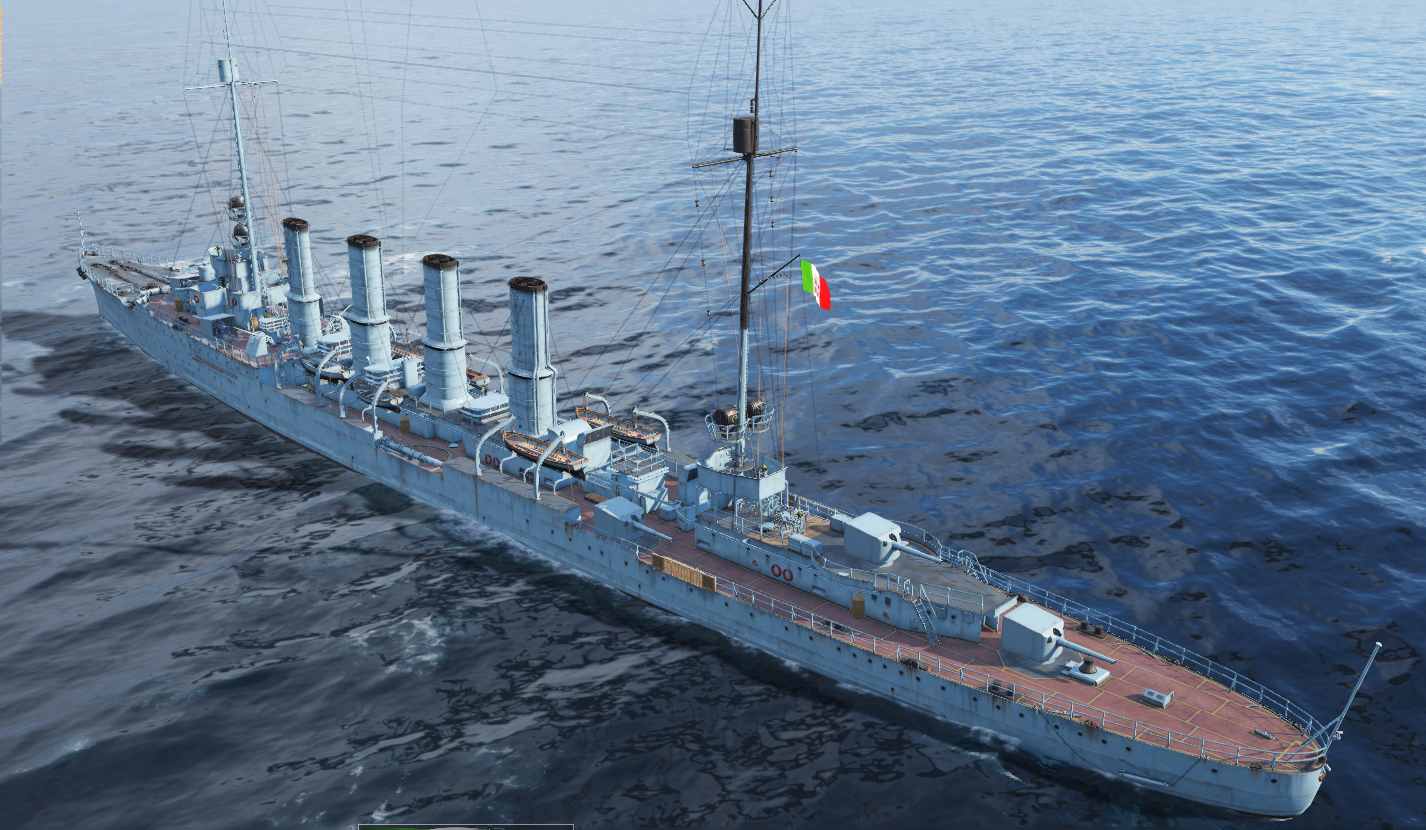
Overview stern view of the Magdeburg class
Armament
The four cruisers mounted a battery of twelve 10.5 cm SK L/45 guns in single pedestal mounts, two were in tandem forward on the forecastle, eight amidships, two in tandem aft. Each of these guns had a maximum elevation of 30°, reaching out 12,700 m (13,900 yd) in overall range. In total the ship carried 1,800 rounds of ammunition, AP and HP, around 150 shells for each gun. Apart that they were only armed for close quarters by a pair of 500 mm (19.7 in) torpedo tubes submerged and broadside. Each tubes was provided by five torpedo reloeads. Also as the design permitted, these cruisers could also carry 120 mines on rails running from the stern to the forcastle.
1915-16, the Strassburg et Stralsund were rearmed with seven 150 mm gus (6-in) in single positions, and two 88 mm DP, plus two additional Torpedo tubes on deck. SMS Breslau was later rearmed with two more 150 mm guns, in 1916, but one was later removed and she ended with eight main guns in 1917.
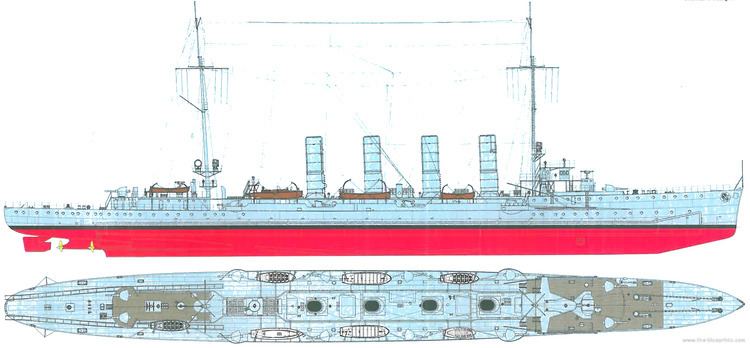
2 views showing the ships general configuration – src the blueprints.com

An old profile of the Magdeburg class for “weapons’ encyclopedia”, 1980 Atlas collection.
Links
Conway’s all the world fighting ships 1921-1947.
The Magdeburg class on wikipedia
The Breslau on wikipedia
Discovery of the wreck of the Midilli (pdf)
The Magdeburg on alchetron.com
le.fantasque.free.fr/php3/ship.php3?page_code=magdeburg
www.german-navy.de/hochseeflotte/ships/smallcruiser/magdeburg/history.html
www.historynet.com/the-wreck-of-the-magdeburg.htm
www.worldwar1.co.uk/cruisers/sms-magdeberg.html
www.militaer-wissen.de/small-cruiser-sms-magdeburg/?lang=en
Models Corner:
1/700 rare Armo Model
Scratchbuilt model example
3D corner:
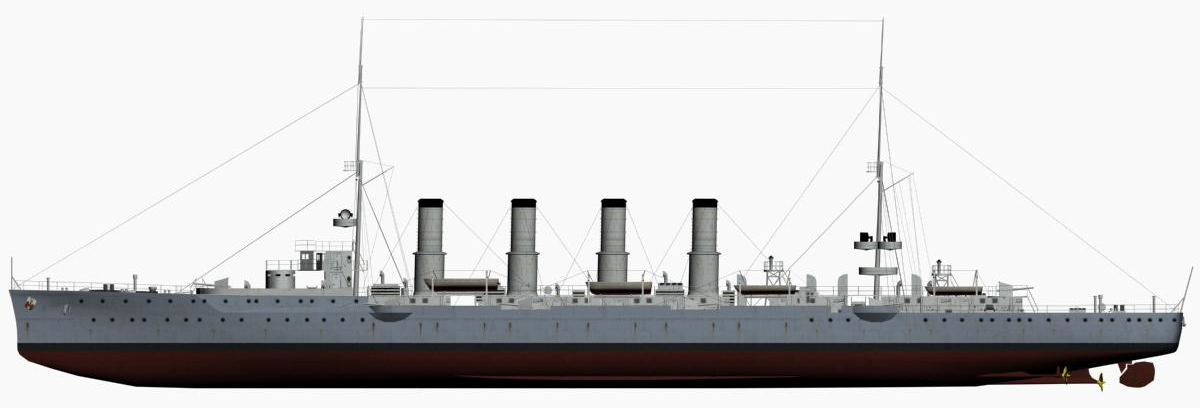
3D Rendition on Turbosquid – SRC
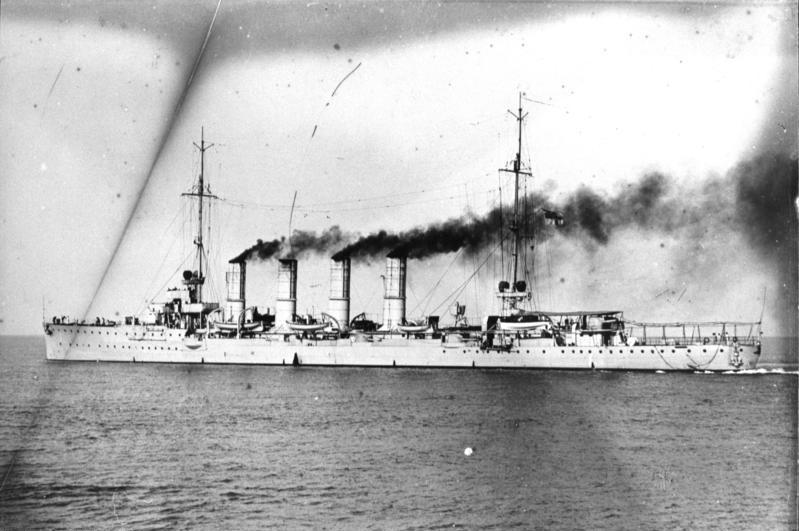
Stapellauf: 16.5.1911
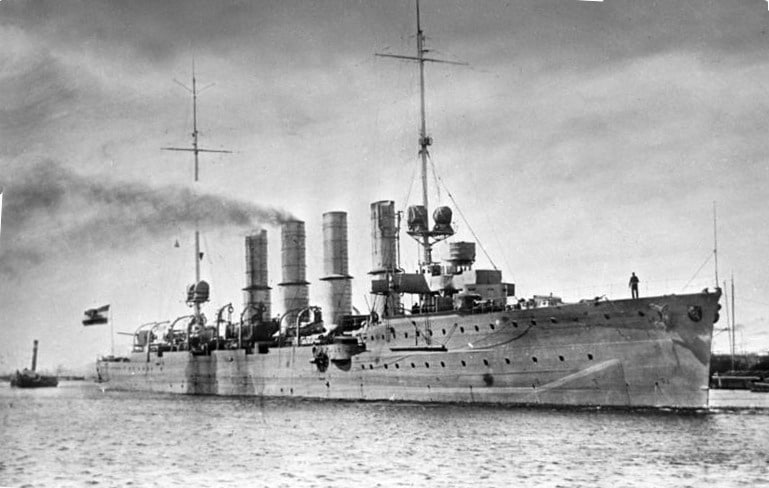

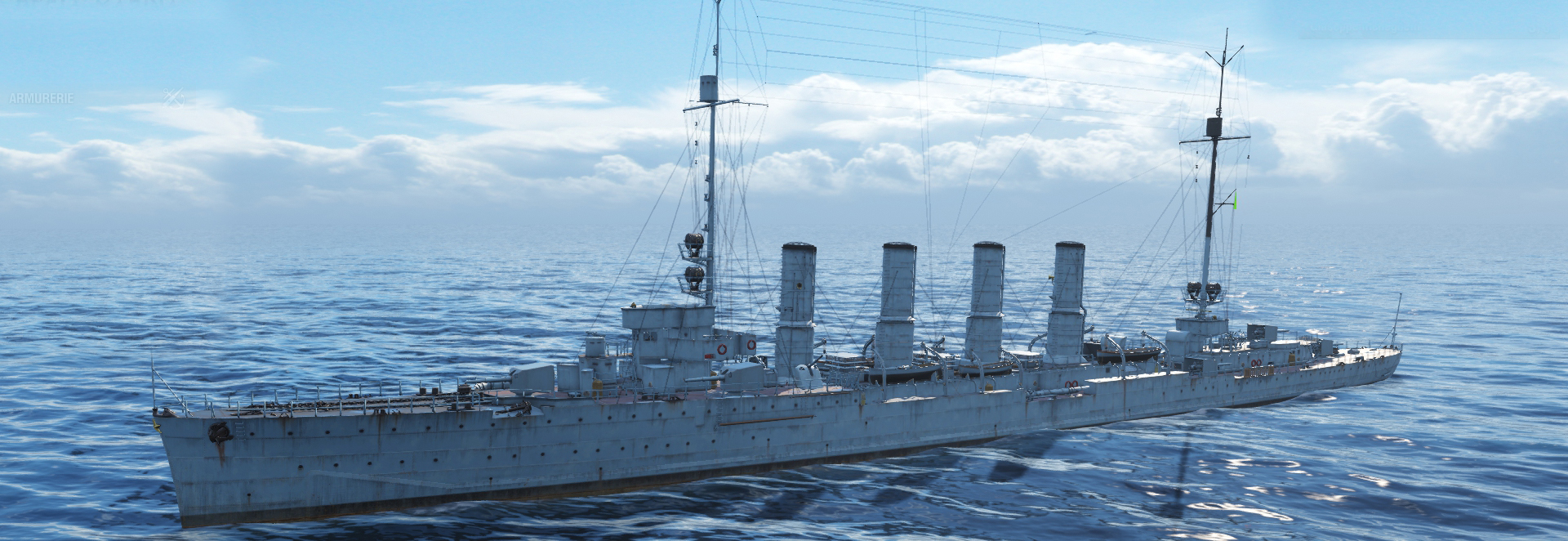
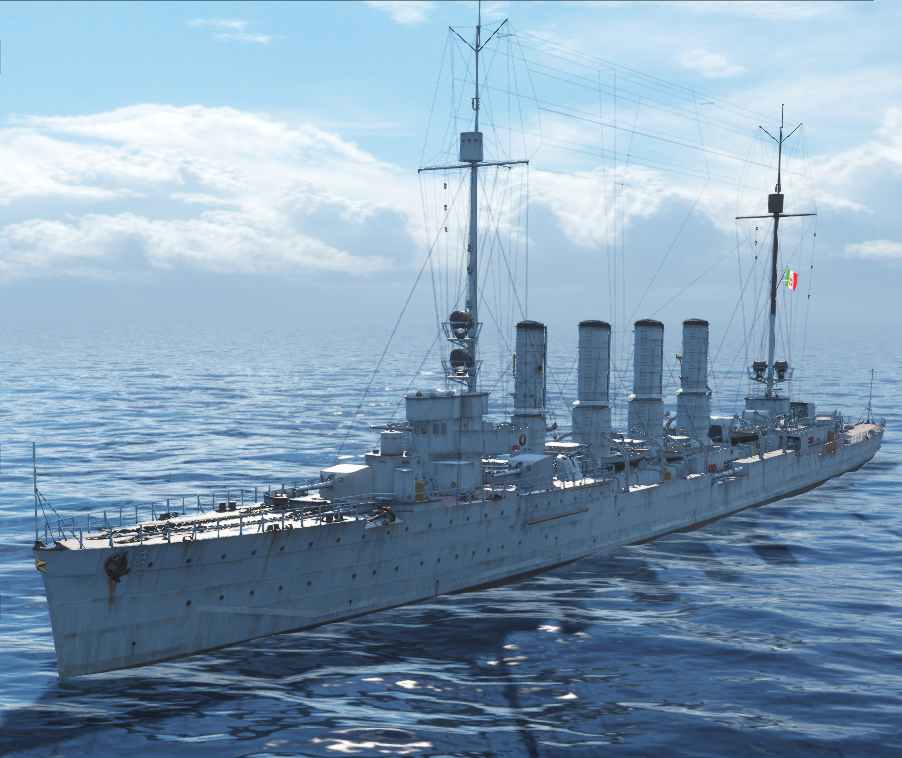
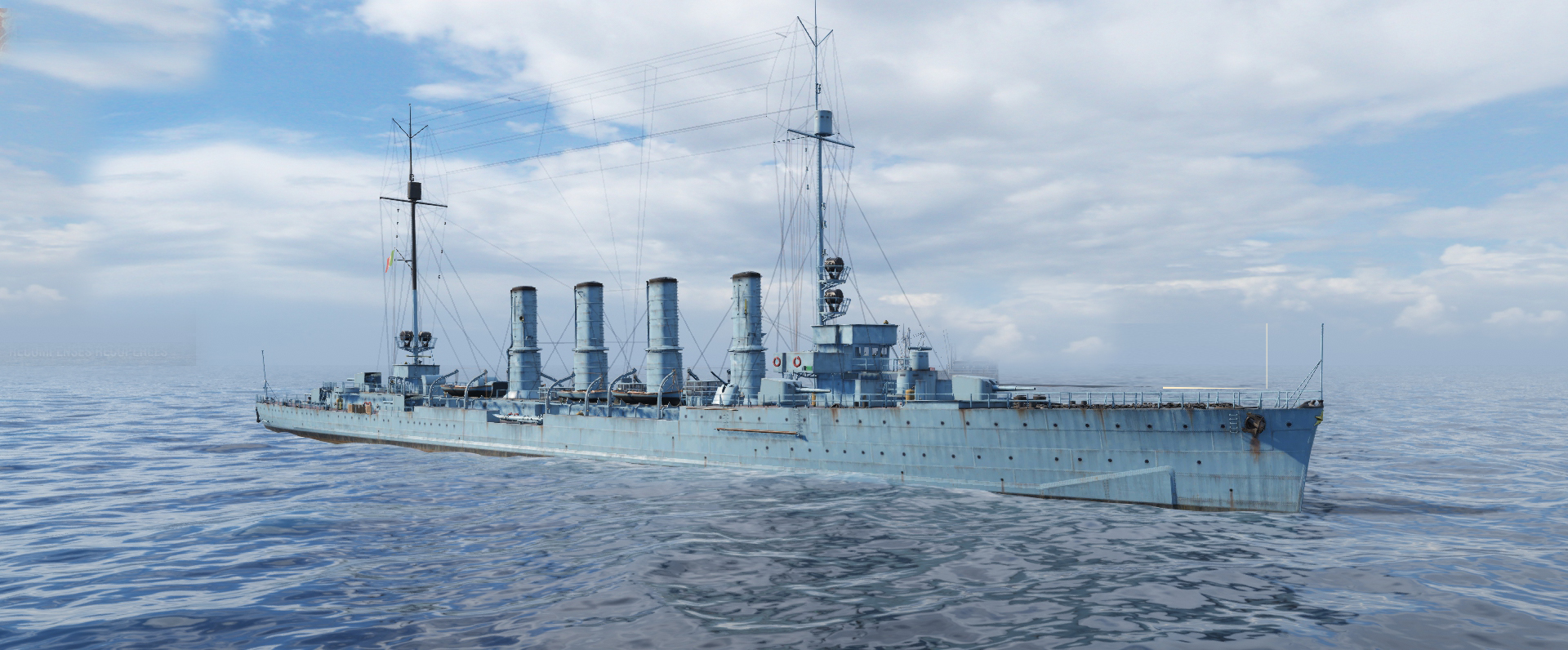
Other rendition views of the Magdeburg class in HD (WoW).
Magdeburg class specifications |
|
| Dimensions | 138,7 x 13,5 x 4,4 m (455 ft 1 in x 44 ft 3 in x 14 ft 5 in) |
| Displacement | 4570t – 5587t FL – 4500-5500 Long Tonnes |
| Crew | 336+18 |
| Propulsion | 3 shaft, 3 steam turbines, 16 standard watertubes boilers, 25,000-29,000 hp (see notes) |
| Speed | 27,5 – 28,2 knots top speed |
| Range | 5,820 nmi (10,780 km; 6,700 mi) @ 12 knots |
| Armament | 12 x 105 mm, 2 x 500 mm Sub TTs, 120 mines (Origin) 1917: 7 × 150 mm (5.9 in), 2 × 88 mm SK L/45 guns AA, 2 TTs |
| Armor | Belt: 60 mm (2.4 in), Conning tower: 100 mm (3.9 in) |
Author’s illustration of the Magdeburg in 1914
SMS Magdeburg
SMS Magdeburg was built by AG Weser, Bremen for the cost of 8,058,000 mark. She has been laid down in 1910 under the contract name “Ersatz Bussard”, launched on 13 May 1911 and commissioned on 20 August 1912. First, she served as a torpedo test ship. and after the outbreak opf war in August 1914, she patrolled the Baltic Sea under supervision of Rear Admiral Robert Mischke. On 2 August she fired her first shots in anger on the Russian port of Libau while her sister ship SMS Augsburg was laying a minefield near the entrance of the harbor. Libau was already empty by that time, and was quickly secured by German troops.
The minefield however would prove more an hinderance for German operations than the Russians. The German Baltic fleet conducted further Russian positions shellings, up to 12 August, when Magdeburg herself destroyed the Dagerort lighthouse. Five days later, Magdeburg, Augsburg, three destroyers and the minelayer SMS Deutschland met the Russian armoured rcuisers Admiral Makarov and Gromoboi. However the Russian commander misidentified the Germans for the Roon and Prinz Heinrich, turned and withdrew without firing a shot.
Magdeburg had a fairly short career, and it ended after Prince Heinrich replaced Mischke with Rear Admiral Behring at the head of the Batlci fleet, immediately ordering another operation for 26 August. The idea was to detect Russian forces in the entrance to the Gulf of Finland. However on the early morning mist, while Magdeburg was on her way, she ran aground off the lighthouse at Odensholm (Estonian coast). V26, the destroyer which escorted her, was launched towing cable and tried to pull her free. It was unseless and and instead, evacuated the whole Magdeburg’s crew.
Meanwhile, the Russian cruisers Bogatyr and Pallada spotted the stranded cruiser. They soon opened fire, but soon stopped as it was found more judicious to captured the ship. Menawhile, the Germans attempted to scuttle her, and detonated the forward section of the ship, but they were forced to leave when the Russian arrived to board the ship. Fifteen crew members were killed in the attack, but the German code books has not be destroyed and fell into Russian’s hands, a crucial intelligence breakthrough.
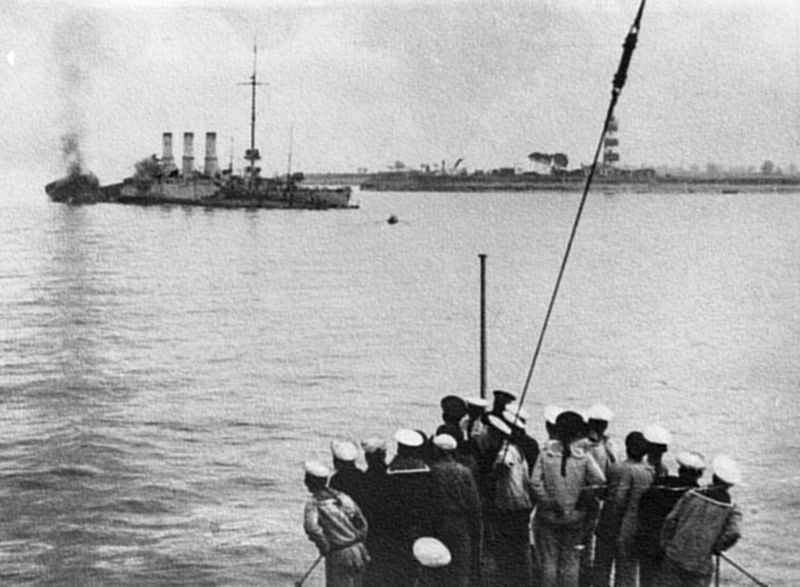
The Magdeburg, stranded at Odensholm lighthouse, with her crew evacuated, seen from rescuing destroyer V26. Under fire and threat from Russian cruisers, the last remaining crew and officers failed to destroy codebooks. This will have huge repercussions on sea operations during the war, a major intelligence coup not alike the capture of the enigma machine onboard a U-Boote durning WW2.
Indeed these three codebooks went with the current encryption key. A copy was soon passed onto the British Royal Navy on 13 October, and this would weight heavily in the upcoming naval engagements. The recent deciphering department, Room 40 was now able to process intercepted German wireless signals, and served well Admiral John Jellicoe, commander of the Grand Fleet. This intelligence proved important both at the Battles of Dogger Bank and Jutland. The Russian Navy will study the ship and eventually scrap her in situ, completely destroying the wreck which caused a hazard in the area.
SMS Breslau (Later Midilli)
The SMS Breslau was laid down at A.G. Vulcan also in 1910, launched on 16 May 1911 and Commissioned on 10 May 1912 under the “Ersatz Falke” contract. As soon as she was ready and her crew sufficiently drilled she left Germany for the Mediterranean, joining the brand new Mittelmeerdivision (Mediterranean Division), teaming with the equally new battlecruiser SMS Goeben under the command of Admiral Wilhelm Souchon. The squadron was created by the Kaiser after he estimated the Reich needed to be present after the Balkan war of 1912. Among other officers, the SMS Breslau carried Leutnant zur See Karl Dönitz, from September 1913.
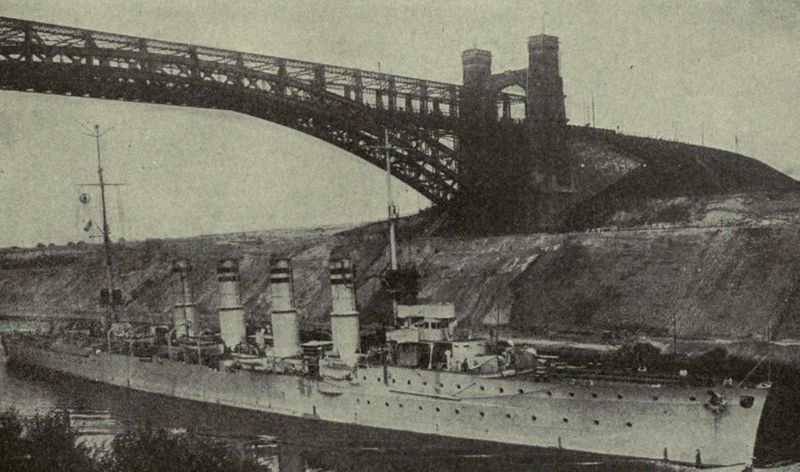
Breslau crossing Kiel canal.
When the war broke out, both ships were in perilous position, with only the Gibraltar strait controlled by the British as a safe passage home and French ports and fleet in between. Both received orders to interdict French transports transferring troops from Algeria to France. On 3 August 1914 both ships had to leave Alexandrian waters, as the ritish were still not at war, steaming off Algeria. About 06:00, SMS Breslau shelled Bône and Goeben Philippeville, embarking troops.
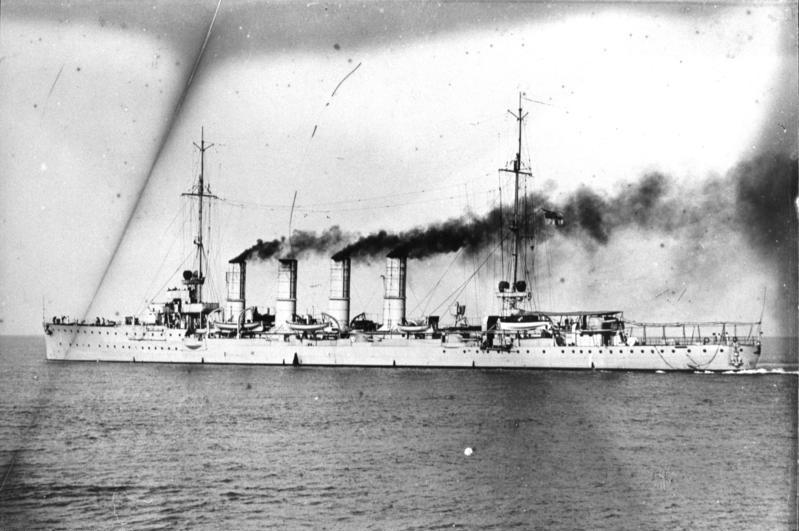
Breslau in 1911 – Bundesarchiv
Damage was limited and Souchon quickly broke off, heading for Messina for coaling. During their trip they were shadowed by HMS Indomitable and Indefatigable. On the 5 August this tie, UK was at war and Souchon met another collier in the Aegean and then after revising with is officers about the best course, headed at dawn on the 6, for Constantinople. The only possible way, and with the British Mediterranean Fleet hot on his heels. Troubridge’s 1st Cruiser Squadron indeed intercepted the Germans and briefly exchanged fire. HMS Gloucester duelled shortly with Breslau, but Troubridge broke off as the Goeben made ready his 28 cm (11 in) guns to fire.
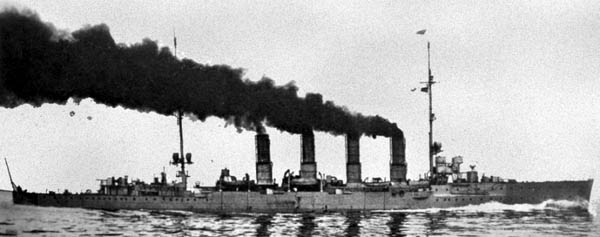
On 8 August, the Breslau met the intended collier off Donoussa (Naxos). After coaling on the 10, she and Goeben entered the Dardanelles and were screened by Turkish ships on their way to Constantinople. The move could caue an international diplomatic outrage as Turkey was neutral at that time, so Goeben received orders to transfer both ships to the Ottoman Navy. This took place on 16 August, but the sale never took place and all officers and sailors accepted to serve from then on for the Turkish Fleet. On 23 September, Souchon even became the commander of the entire Turkish fleet while both ships were renamed, in addition to their new flag.
SMS Breslau became officially Midilli and Goeben the Yavuz Sultan Selim. Now with Ottoman uniforms and fezzes the crews made ready for action again as the neutrality would not span very long. The British stationed a blockading force outside the Dardanelles with order to sink both ships whatever their flag for some time, at least until Turkey was found at war with the entente. For the complete carrer of the Midilli, this is however another story which will be treated in a standalone post. Her career mostly saw her in action in the black sea, and she met her fate at the Battle of Imbros in 1918.
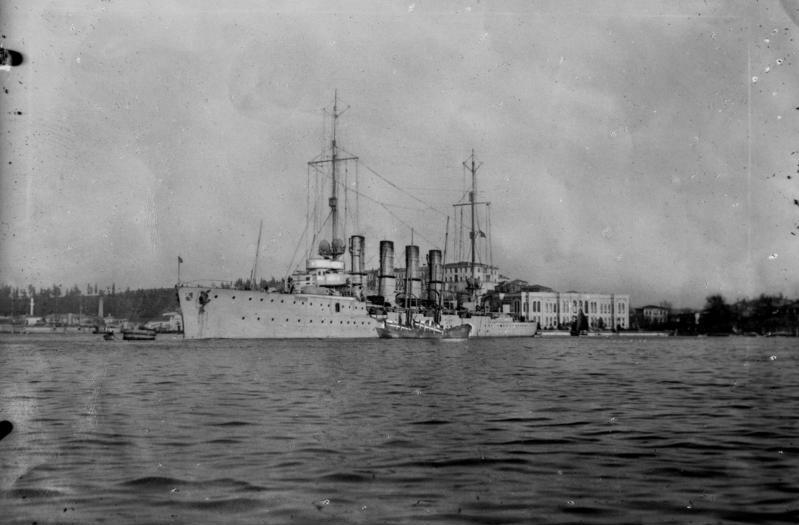
Kleiner Kreuzer Midilli (Breslau) under Turkish Flag, notice Topcapi palace behind.
SMS Strassburg (Later Taranto)
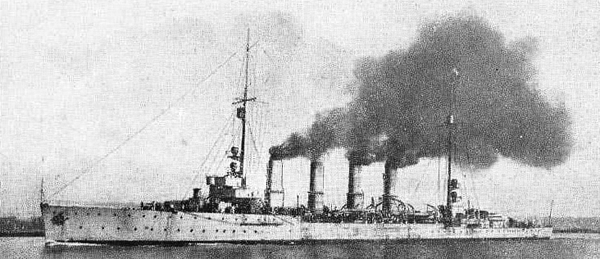
The Strassburg (from the French city of Strasbourg, part of Alsace, by then part of the German Empire from 1870), was laid down as part of the contact Ersatz Condor at Kaiserliche Werft, Wilhelmshaven in 1910 and commissioned on October 1912. Her first assignation was overseas and her engines were of a brand new configuration which needed extra long-term testings and observation. Her first mission was therefore a long-distance cruise as the same propulsion system was recently installed in the battleships Kaiser and König Albert.
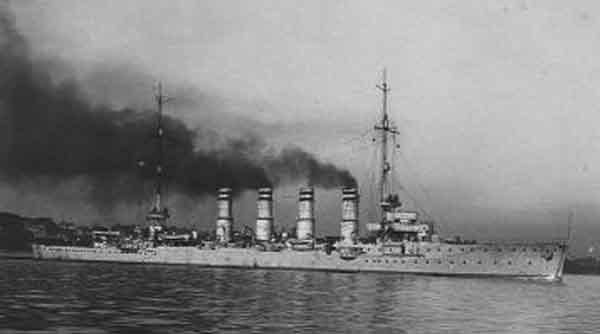
The three ships observed were part of the special “Detached Division”. which departed Germany on 9 December 1913 and proceeded to the German colonies in western Africa, visited Lomé (Togoland), Duala and Victoria in Kamerun, and Swakopmund (South-West Africa). From there they sailed to the remote island of St. Helena and proceeded through the south Atlantic, reaching Rio de Janeiro on 15 February 1914. SMS Strassburg alone resumed her trip to Buenos Aires before meeting the two battleships in Montevideo. All three also crossed the Cape Horn and headed for Valparaiso, reaching the Chilean harbour on 2 April. A week after, they headed back to Germany, visiting Bahía Blanca in Argentina and stopping at Rio de Janeiro again, then Cape Verde and Vigo in Spain, reaching Kiel on 17 June 1914. This was a 20,000 nautical miles (37,000 km; 23,000 mi) trip which was indeed quite intructive on the new powerplant, and upon arrival, the Detached Division was dissolved. Before the war, Strassburg served with the reconnaissance forces of the Hochseeflotte.
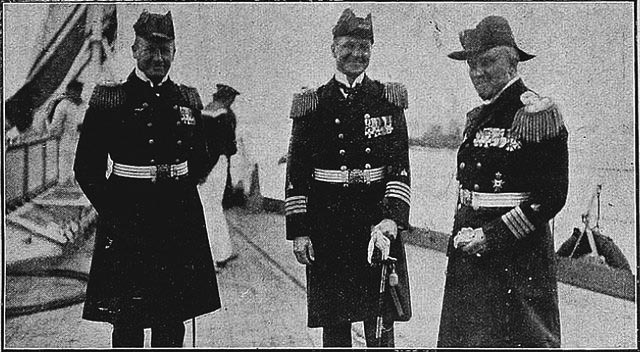
Strassburg and Stralsund made a sweep into the Hoofden, seeking opposing British reconnaissance forces and indeed on On 16 August, they soon stumbled upon a group of sixteen British destroyers led by a light cruiser, spotted by fair weather at about 10,000 m (33,000 ft), but since they were outnumbered, both German cruisers broke off. Later SMS Strassburg would fight in the Battle of Heligoland Bight on 28 August. Opposing the British battlecruisers and light cruisers was Rear Admiral Leberecht Maass and his cruisers, in another reconnaissance sweep this day.
SMS Strassburg was first to leave port, reinforcing the German reconnaissance forces heavily engaged. At 11:00, she fell on the already badly damaged HMS Arethusa, by SMS Stettin and Frauenlob. She was about to finish her off when the 1st Destroyer Flotilla interposed and repelled her. She soon lost contact in the mist, but heared them again at 13:10, driven by the sound of gunfire and explosions on the cruiser Mainz. Together with SMS Cöln, she engaged and damaged the British destroyers HMS Laertes, Laurel, and Liberty. Both were driven off by vigorous attacks from the remainng destroyers. British battlecruisers in the end spotted them, engaged and sank SMS Ariadne and Cöln. On board was rear admiral Maass, as this was his flagship. Strassburg and the surviving force broke off and ran in the haze, later to be reinforced on their way home by the battlecruisers of the 1st Scouting Group.
As the raid on Scarborough, Hartlepool and Whitby (15–16 December) ended, the battlecruisers of Rear Admiral Franz von Hipper’s I Scouting Group withdrawn. But British ships were at sea to intercept them and Strassburg and other screening cruisers leading two flotillas of torpedo boats tried themselves to cross the two British squadrons. There was a heavy mist which reduced vision to 4,000 yd (3,700 m) and only SS Stralsund was spotted by the British, which fire dand missed. The withdrawal was completed and Strassburg was later transferred to the Baltic in 1916. he would miss the Battle of Jutland and the next year, she joined the VI Scouting Group.
The latter participated in Operation Albion in the Gulf of Riga on 14 October 1917. Strassburg, Kolberg, and Augsburg departed Libau, escorting minesweepers to the Gulf of Riga. They were engaged by 12-inch (300 mm) coastal guns and later anchored off the Mikailovsk Bank, guarding at a distance the minesweepers doing their job for two days. They will depat two days later to join the dreadnoughts König and Kronprinz, which made a sortie in the Gulf of Riga. Sure enough, the Russians sailed to intercept them, and this was the start of the Battle of Moon Sound, opposing the Slava and Grazhdanin. On 21 October, SMS Strassburg and Markgraf shelled the island of Kyno and the port of Salismünde. The island was later captured.
In October 1918, Strassburg joined the IV Scouting Group. Admirals Reinhard Scheer and Hipper devised a new plan (the last) to attract the British Grand Fleet and inflict as much damage as possible, whatever the cost to the fleet. This started in the morning of 27 October. However mutiny already plagues their ships. 45 crew members from Strassburg were missing and had to be found inside Wilhelmshaven, rounded up and forced back to the ship. She sailed to Cuxhaven, met six other cruisers there which soon mutinied. All were supported the armistice proposed by Prince Maximilian. On the morning of 29 October 1918 the ships were ordered to Wilhelmshaven but a new mutiny started on Thüringen and soon spread in other battleships. Hipper and Scheer cancelled the operation.
In November, Strassburg and Brummer joined Sassnitz and the Strassburg’s commander took command of the port’s naval forces, inviting a revolutionary sailor’s council. She escaped the great departure of the fleet to Scapa Flow, and served instead in the reorganized Reichsmarine in 1919, stricken on 10 March 1920 and ceded to Italy as a war prize. There, she would be recommissioned as Taranto, and served with the Regia Marina with some modifications (see italian cruisers in WW2 and the Regia marina page).
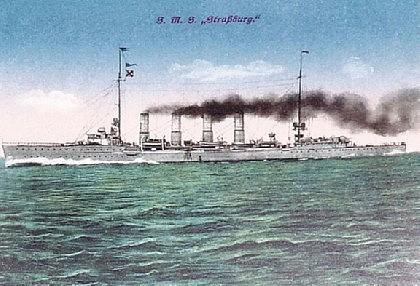
SMS Stralsund (Later Mulhouse)
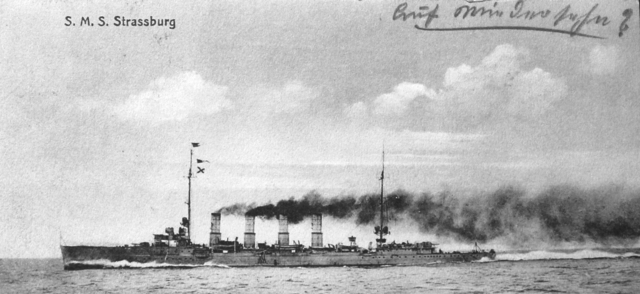
Stralsund was laid down at AG Weser, Bremen in 1910, launched on 4 November 1911, and commissioned on 10 December 1912, under contract “Ersatz Cormoran”. Until the war broke oout, she was in the reconnaissance forces of the High Seas Fleet. She teamed ith Strassburg when on 16 August sweep into the Hoofden they met 16 British destroyers led by a cruiser, and broke off. She however was fully engaged during the Battle of Heligoland Bight on 28 August 1914. Stralsund, Danzig, and Ariadne arrived to reinforced rear-admiral Mass’s battlecruiser group, turnind the tide against the British light cruisers before being repelled by British Battlecruisers. Before escaping into the fog back home, Stralsund managed to rescue most of the crew of the sunken Ariadne.
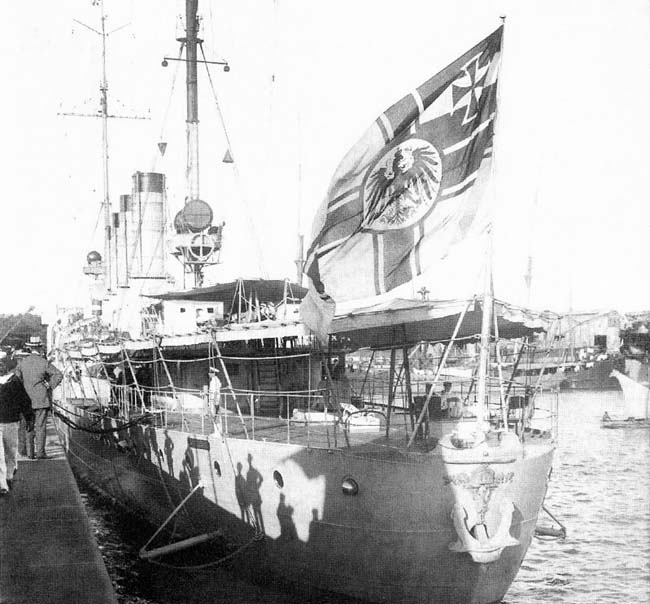
She also was part of the raid on Yarmouth on 2–3 November 1914. Instead of shelling the city she laid a minefield, later claiming a steamer and submarine HMS D5, trying to intercept the German raiders. Later she would also took part in the raid on Scarborough, Hartlepool and Whitby, spotted by missed by the HMS Southampton. Her speed saved her again. During the later British Cuxhaven Raid on 25 December 1914, and Nordholz Airbase she fired and tried to down several British seaplanes, without success.
SMS Stralsund was in the reconnaissance screen, I Scouting Group, at the Battle of Dogger Bank, 24 January 1915. Teaming with Graudenz, she was assigned to the vanguard screen, Rostock and Kolberg steaming each side and supported by a half-flotilla of torpedo boats each. Their lookouts spotted heavy smoke afar at 08:15, battleships approaching. The Hochseeflotte however was in port and unable to support the battlecruisers. Hipper was breaking off when the British battlecruisers catch up and sank the Blücher. Stralsund missed the Battle of Jutland as she was rearmed with the new 15 cm SK L/45 guns and two 8.8 cm SK L/45 guns, a refit made at the Kaiserliche Werft, Kiel. On 2 February 1918, SMS Stralsund struck a mine in the North Sea but she was able to make it back to port under good escort. In repairs, she missed a sortie on 23–24 April 1918 to intercept a British convoy to Norway.

Stralsund in the baltic (CC) – cropped.
The war ended and she would serve briefly into the reorganized Reichsmarine in 1919, before the Treaty of Versailles had her disarmed, handed over to the Allies and eventually ceded to France as a war prize, acted in Cherbourg on 3 August 1920. She was rearmed with her 8.8 cm guns replaced by French 75 mm (3.0 in) AA guns. Under the new name of Mulhouse, the cruiser served with the French Mediterranean Fleet, 3rd Light Division newly formed with the ex-German cruisers Metz and Strasbourg, and ex-Austro-Hungarian Thionville. She would remain in service until a 1925 refit in Brest but was worn out and placed in reserve shortly after. On 15 February 1933, she was stricken from the naval register, broken up in Brest in 1935. Her bell was later returned to Germany, now on display at the Laboe Naval Memorial.

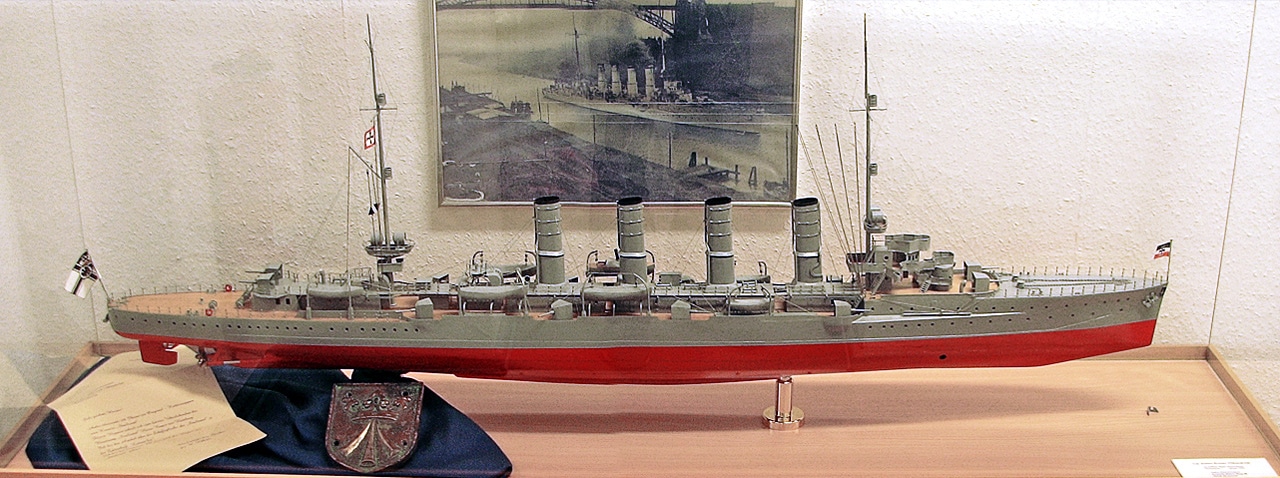

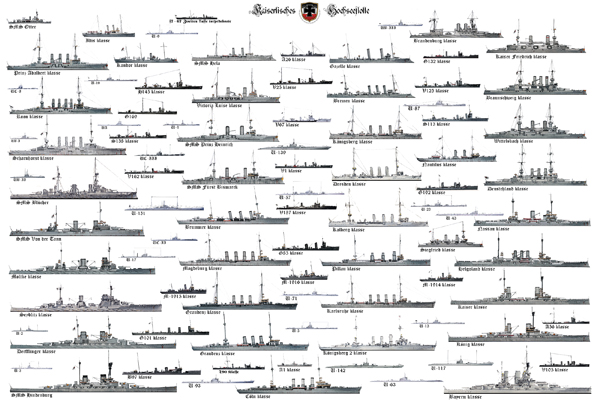
 Latest Facebook Entry -
Latest Facebook Entry -  X(Tweeter) Naval Encyclopedia's deck archive
X(Tweeter) Naval Encyclopedia's deck archive Instagram (@navalencyc)
Instagram (@navalencyc)





 Austrian Navy
Austrian Navy French Navy
French Navy Royal Navy
Royal Navy Armada Espanola
Armada Espanola K.u.K. Kriegsmarine
K.u.K. Kriegsmarine Dansk Marine
Dansk Marine Nautiko Hellenon
Nautiko Hellenon Koninklije Marine 1870
Koninklije Marine 1870 Marinha do Brasil
Marinha do Brasil Osmanlı Donanması
Osmanlı Donanması Marina Do Peru
Marina Do Peru Marinha do Portugal
Marinha do Portugal Regia Marina 1870
Regia Marina 1870 Nihhon Kaigun 1870
Nihhon Kaigun 1870 Preußische Marine 1870
Preußische Marine 1870 Russkiy Flot 1870
Russkiy Flot 1870 Svenska marinen
Svenska marinen Søværnet
Søværnet Union Navy
Union Navy Confederate Navy
Confederate Navy Armada de Argentina
Armada de Argentina Imperial Chinese Navy
Imperial Chinese Navy Marinha do Portugal
Marinha do Portugal Mexico
Mexico Kaiserliche Marine
Kaiserliche Marine 1898 US Navy
1898 US Navy Russkiy Flot
Russkiy Flot Sovietskiy Flot
Sovietskiy Flot Royal Canadian Navy
Royal Canadian Navy Royal Australian Navy
Royal Australian Navy RNZN Fleet
RNZN Fleet Chinese Navy 1937
Chinese Navy 1937 Kriegsmarine
Kriegsmarine Chilean Navy
Chilean Navy Danish Navy
Danish Navy Finnish Navy
Finnish Navy Hellenic Navy
Hellenic Navy Polish Navy
Polish Navy Romanian Navy
Romanian Navy Turkish Navy
Turkish Navy Royal Yugoslav Navy
Royal Yugoslav Navy Royal Thai Navy
Royal Thai Navy Minor Navies
Minor Navies Albania
Albania Austria
Austria Belgium
Belgium Columbia
Columbia Costa Rica
Costa Rica Cuba
Cuba Czechoslovakia
Czechoslovakia Dominican Republic
Dominican Republic Haiti
Haiti Hungary
Hungary Honduras
Honduras Estonia
Estonia Iceland
Iceland Eire
Eire Equador
Equador Iran
Iran Iraq
Iraq Latvia
Latvia Liberia
Liberia Lithuania
Lithuania Mandchukuo
Mandchukuo Morocco
Morocco Nicaragua
Nicaragua Persia
Persia San Salvador
San Salvador Sarawak
Sarawak Uruguay
Uruguay Venezuela
Venezuela Zanzibar
Zanzibar Warsaw Pact Navies
Warsaw Pact Navies Bulgaria
Bulgaria Hungary
Hungary

 Bundesmarine
Bundesmarine Dutch Navy
Dutch Navy Hellenic Navy
Hellenic Navy Marina Militare
Marina Militare Yugoslav Navy
Yugoslav Navy Chinese Navy
Chinese Navy Indian Navy
Indian Navy Indonesian Navy
Indonesian Navy JMSDF
JMSDF North Korean Navy
North Korean Navy Pakistani Navy
Pakistani Navy Philippines Navy
Philippines Navy ROKN
ROKN Taiwanese Navy
Taiwanese Navy IDF Navy
IDF Navy Royal New Zealand Navy
Royal New Zealand Navy Egyptian Navy
Egyptian Navy South African Navy
South African Navy
































 dbodesign
dbodesign